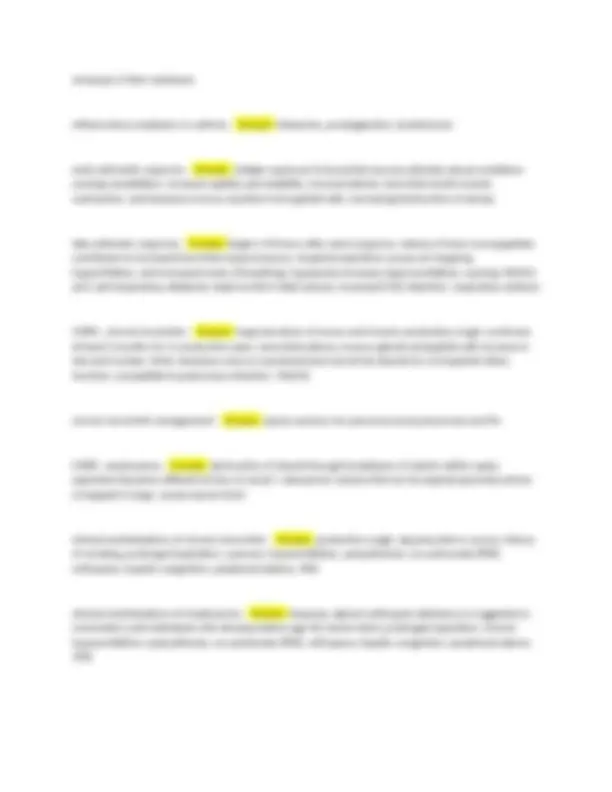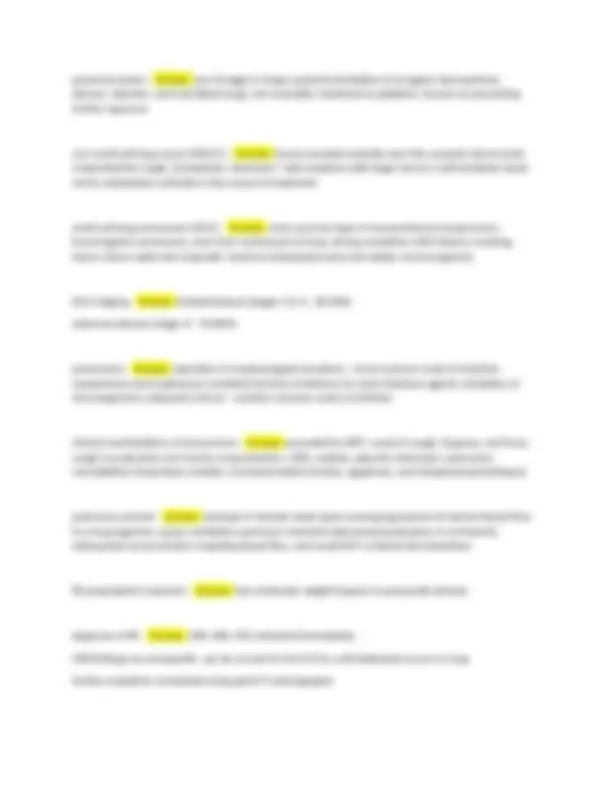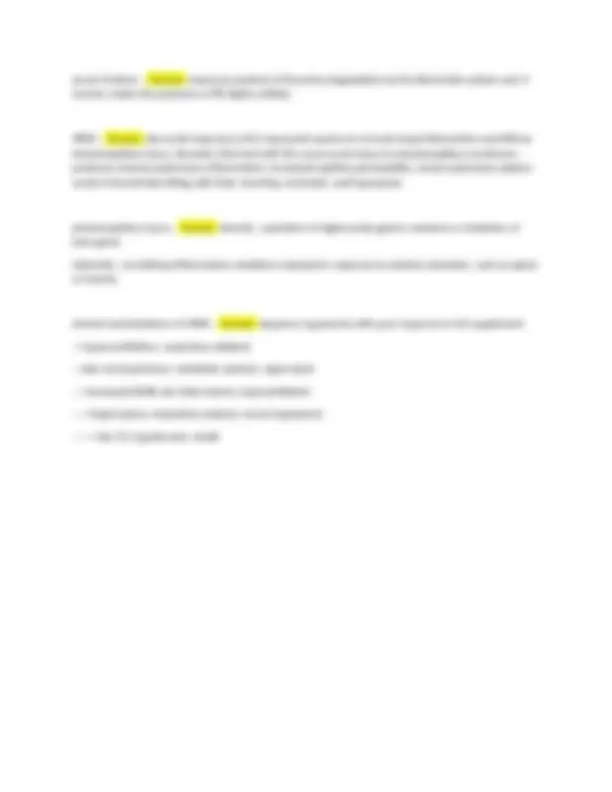





Study with the several resources on Docsity

Earn points by helping other students or get them with a premium plan


Prepare for your exams
Study with the several resources on Docsity

Earn points to download
Earn points by helping other students or get them with a premium plan
Community
Ask the community for help and clear up your study doubts
Discover the best universities in your country according to Docsity users
Free resources
Download our free guides on studying techniques, anxiety management strategies, and thesis advice from Docsity tutors
MU NURS 611 Adv Patho - Exam 4 Review - Pulmonary System Questions and Complete Solutions Graded A+
Typology: Exams
1 / 5

This page cannot be seen from the preview
Don't miss anything!




MU NURS 611: Adv Patho - Exam 4 Review - Pulmonary System Questions and Complete Solutions Graded A+ Denning [Date] [Course title]
eupnea - Answer: normal breathing; RR 8-16 breaths/min tidal volume - Answer: 400-800 ml sigh breaths - Answer: helps maintain normal lung function; usually 1.5 to 2 times normal tidal volume; occurs approximately 10-12x/hr Kussmaul respirations - Answer: slightly increased ventilatory rate, large tidal volume, no expiratory pause Cheyne-Stokes - Answer: characterized by alterhating periods of deep and shallow breathing; apnea lasting 15-60 seconds followed by respirations that increase in volume until peak is reached, then ventilation decreases agin to apnea; results from any condition that slows blood flow to brainstem -> slows impulses sending info to respiraotry centers in brainstem hypoventilation - Answer: inadequate alveolar ventilation in relation to metabolic demands; caused by alterationsin pulmonary mechanics or in neurologic control of breathing such that minute volume (tidalxRR) is reduced; CO@ removal does not keep up with CO2 production, PaCO2 >44mmHg, causing hypercapnia; respiratory acidosis hyperventilation - Answer: response to hypoxemia, anxiety, pain; lungs remove CO2 at faster rate than it is produced by cellular metabolism = PaCO2 <36mmHg (hypocapnia); respiratory alkalosis TB - Answer: transmission through airborne droplets; diagnosed by positive TST/PPD, sputum culture, immunoassays, and chest XR; +test = yearly XR; individuals who have received BCG will have positive TB results; nodules, calcifications, cavities, and hilar enlargement are common in upper lobes TB cultures - Answer: can take up to 6 weeks to become positive when active pulmonary disease is present normal aging changes - Answer: loss of elastic recoil stiffening of chest wall changes in gas exchange
pneumoconiosis - Answer: any hcnages in lungs caused by inhalation of inroganic dust particles; silicosis, asbestos, and coal (black lung); not reversible; treatment is palliative, focuses on preventing further exposure non-small cell lung cancer (NSCLC) - Answer: tumors located centrally near hila, projects into bronchi; nonproductive cough, hemoptysis; chest pain = late symptom with larger tumors; well-localized, tends not to metastasize until late in the course of treatment small cell lung carcinomas (SCLC) - Answer: most common type of neuroendocrine lung tumors; bronchogenic carcinomas; arise from central part of lung; strong correlation wtih tobacco smoking; tumor shows rapid rate of growth, tends to metastasize early and widely; worst prognosis; SCLC staging - Answer: limited disease (stages I to III - 20-30%) extensive disease (stage IV - 70-80%) pneumonia - Answer: aspiration of oropharyngeal secretions - most common route of infection; nasopharynx and oropharynx constitute first line of defense for most infectious agents; inhalation of microorganisms released in the air - another common route of infection clinical manifestations of pneumonia - Answer: preceded by URTI; onset of cough, dyspnea, and fever; cough is productive, but may be nonproductive; chills, malaise, pleuritic chest pain; pulmonary consolidation (inspiratory crackles, increased tactile fremitus, egophony, and whispered pectoriloquy) pulmonary emboli - Answer: example of alveolar dead space causing hypoxemia d/t absent blood flow to a lung segment; causes ventilation-perfusion mismatch (decreased production of surfactant); widespread vasocnstriction impeding blood flow; end result DVT or blood clots elsewhere PE prophylactic treament - Answer: low-molecular-weight heparin or pneumatic devices diagnosis of PE - Answer: CXR, ABG, ECG obtained immediately CXR findings are nonspecific; can be normal for first 24 hrs until atelectasis occurs in lung further evaluation conducted using spiral CT arteriography
serum D dimer - Answer: measures product of thrombus degradation by the fibrinolytic system and, if normal, makes the presence of PE highly unlikely ARDS - Answer: aka acute lung injury (ALI) represents spectrum of acute lung inflammation and diffuse alveolocapillary injury; disorders that end with this cause acute injury to alveolocapillary membrane - produces massive pulmonary inflammation, increased capillary permeability, severe pulmonary edema - result of bronchioles filling with fluid, shunting, mismatch, and hypoxemia alveolocapillary injury - Answer: directly - aspiration of highly acidic gastric contents or inhalation of toxic gases indirectly - circulating inflammatory mediators released in response to systemic disorders, such as sepsis or trauma clinical manifestations of ARDS - Answer: dyspnea, hypoxemia with poor response to O2 supplement -> hyperventilation, respiratory alkalosis -->dec renal perfusion, metabolic acidosis, organ dysfx --->increased WOB, dec tidal volume, hypoventilation ---->hypercapnia, respiratory acidosis, worse hypoxemia -----> dec CO, hypotension, death